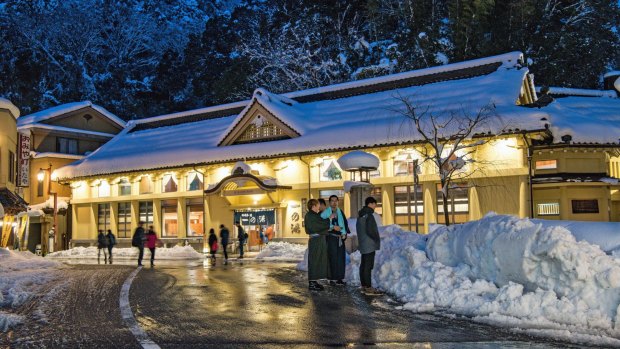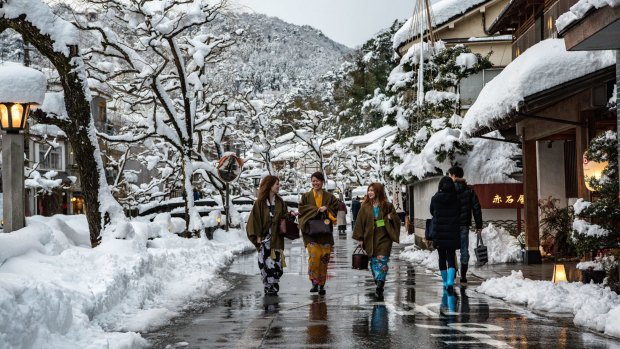This was published 4 years ago
Kinosaki Onsen Japan: The best place to go onsen-hopping
By Brian Johnston

Winter streetscape in Kinosaki Onsen.Credit: Shogo.Nishiyama
There's never a good time to suffer an earthquake, but lunchtime was a particularly bad moment for resort town Kinosaki Onsen in 1925. The rattling knocked over the charcoal braziers traditionally used for cooking, and soon the town's wooden houses were alight. Today an old storehouse, spared the fire thanks to its mud walls, is one of few buildings that pre-date the great North Tajima Earthquake.
Kinosaki residents could have rebuilt willy-nilly and in concrete, and ended up with the blight of ugly buildings, tatty amusements and neon of many of Japan's other once-charming onsen, or hot-spring resorts. Instead, they decided to rebuild the town exactly the way it was – only better. Same-same, but different. The town's canal and streets were widened as future firebreaks. New buildings were earthquake-proofed. Concrete skeletons were concealed beneath wooden cladding.
You wouldn't know that this ancient hot-spring resort, reputedly founded in the eighth century, is a twentieth-century reinvention. Willow and cherry trees weep over its canal-bound river whose bridges are anchored by stone lanterns. The cherry trees make this a popular place in springtime, but winter lures visitors in the know to snow-scapes and for popular seasonal speciality, snow crab.

Kinosaki Onsen Credit: Shogo.Nishiyama
Some of the architecture of Kinosaki's wooden houses would satisfy the samurai. Its Shinto temple in the middle of town is mossy and mellow and hung with white paper lanterns. The main shopping street looks scarcely different from it did in the Taisho Era before the earthquake, perhaps with the exception of the polystyrene boxes filled with ice that display snow crabs for the delectation of passers-by.
A small museum room for guests at Nishimuraya Honkan, the town's best ryokan, has some wonderful old photos of Kinosaki and artefacts from its long history, including late-1800s samurai armour. Check out a one-time Japanese prime minister in a white Western suit posing with a group in front of a seaplane – he sports extraordinary whiskers.
The ryokan's owner Soichiro Nishimura is the great-grandson of the wise mayor who guided the town to its post-earthquake recovery, but he's the seventh-generation innkeeper here. The ryokan is like the town, seemingly ageless despite its modern additions – an annexe was added in the 1960s. The ryokan has creaking stairs and tatami rooms and wooden corridors that zigzag around Zen-inspired traditional gardens.
In the evenings ladies in kimonos serve multi-course kaiseki meals in your room, featuring sashimi of sea bream and amberjack, and fresh snow crab with a vinegar dip, and hotpot of Tajima beef with vegetables. You sit over pickles and rice, gazing out onto bonsai through wood-latticed windows, and feel as if time has stood still.
Kinosaki Onsen's prettiness, almost-coastal location in forested hills and fine ryokans aren't the only reason this is Japan's best hot-spring resort, though. In many other places, big companies have built large ryokans that provide customers with few reasons to move beyond their own bathing facilities, shops and restaurants. As a result, traditional businesses have died and streets can be eerily empty.
Kinosaki, though, limits development. Not too many big hotels, no rowdy pachinko parlours, a town compact enough to walk, a policy of encouraging local shops. There are seven hot-spring baths and, if you stay here, you get a complimentary pass to all of them – Kinosaki was the first place in Japan to introduce the concept of onsen-hopping, and still the most successful.
The result is a lively town, where visitors stroll about in yukatas from café to craft shop to bathhouse, and where locals still shop. On winter nights, shop windows add a golden glow to dark evenings. Traditional crafts are still active. Kami straw weaving was introduced here 300 years ago, reputedly by an onsen visitor who couldn't afford his ryokan bill and paid in handicrafts instead. You can see a master craftsman at work in his shop and buy a lovely woven box. You can give weaving a go yourself at Kinosaki Straw Craft Museum.
There's nothing old-fashioned about Kinosaki's organisation though. You arrive off a train from Kyoto and a free shuttle will bring you to your hotel. If you want to walk and get right into the onsen spirit from the get-go, you can take a pair of geta (wooden shoes) from a rack and clop off into town. If you're waiting to depart, you can use the public footbath to soothe tired feet before boarding the train. You can drop in at the sophisticated tourist office and avail yourself of abundant information in English about sights, local food specialities (snow crab, Tajima beef, soba noodles) and the etiquette of onsen visits.
There are all sorts of myths associated with these waters. Yanagi-yu bathhouse is good for childbirth. Ichino-yu, where you bathe in a cave, brings good fortune in studies. Goshono-yu is the nicest. It's designed to look like Kyoto's imperial palace in miniature and has lovely outdoor baths beside a waterfall. If you're here in winter, you'll discover the pleasure of rising steam and falling snow as you wallow in the warmth.
Kouno-yu is the oldest of the hot-spring bathhouses, quiet and with a view over hills on which bamboo forest creaks. Legend has it water erupted here after the Buddhist monk Douchi Shonin chanted for a thousand days. If you hike up into the hills (or take the ropeway) above town you arrive at Onsen-ji Temple, which is dedicated to the eighth-century monk. It holds an ancient wooden statue of Kannon, goddess of mercy, which is revealed only every three years in 30.
The goddess, as it happens, is currently on display until April 2021. The boddhisatva has three lotus flowers in one hand and a shower of brassy ornaments over its head. Strings wrapped around its wrist loop across the ceiling and descend so that people praying can touch the other ends. The statue has a rough-hewn, ageless power, glimmering amid the temple's candles and altar offerings.
The temple interior is shadowy and atmospheric and looks as if it has been there for a thousand years. Smoke drifts from a brazier. You burn your wooden fortune sticks in the fire, and let the smoke waft over you for good luck. Maybe the smoke of 1925 brought good luck to Kinosaki too, in the end. A new beginning for an old town that has never looked so good.
TRIP NOTES
FLY
Japan Airlines flies from Melbourne and Sydney to Osaka, a very scenic three-hour train ride from Kinosaki Onsen. Phone 1300 525 287, see au.jal.com
TRAIN
A Japan Rail Pass makes getting around on Japan's outstanding train system even easier. Rail Europe offers passes from $390 per adult. See railplus.com.au
STAY
Nishimuraya Honkan is one of Japan's best ryokans (traditional inns) and a member of Relais & Châteaux, whose properties are notable for their historic atmosphere and top-notch cuisine. It has two delightful onsen baths and rooms overlooking clipped, traditional gardens. Sister property Nishimuraya Hotel Shogetsutei has large, attractive Japanese- and western-style rooms, private onsen spa facilities, excellent restaurants and a stunning lobby outlook onto a tumbling stream. See nishimuraya.ne.jp
MORE
Brian Johnston was a guest of Japan Airlines, Toyooka City Hall and Rail Europe.
Sign up for the Traveller Deals newsletter
Get exclusive travel deals delivered straight to your inbox. Sign up now.